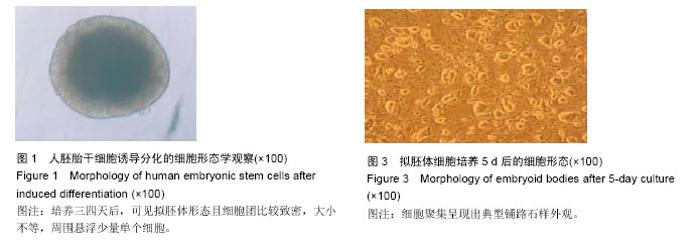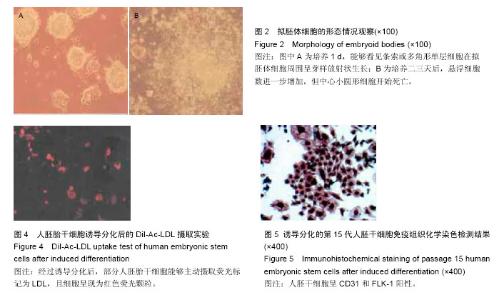Chinese Journal of Tissue Engineering Research ›› 2016, Vol. 20 ›› Issue (23): 3394-3399.doi: 10.3969/j.issn.2095-4344.2016.23.007
Previous Articles Next Articles
Induced differentiation of human embryonic stem cells into endothelial cells
Shi Yang, Shen Jun-sheng, Wu Tao-tao, Li Xiao-fei
- Medical School of Henan University of Science and Technology, Jiaozuo 454003, Henan Province, China
-
Received:2016-03-18Online:2016-06-03Published:2016-06-03 -
About author:Shi Yang, Associate professor, Medical School of Henan University of Science and Technology, Jiaozuo 454003, Henan Province, China
CLC Number:
Cite this article
Shi Yang, Shen Jun-sheng, Wu Tao-tao, Li Xiao-fei. Induced differentiation of human embryonic stem cells into endothelial cells[J]. Chinese Journal of Tissue Engineering Research, 2016, 20(23): 3394-3399.
share this article

2.1 人胚胎干细胞诱导分化的细胞形态学观察 在采用无血清培养基mTeSR1培养条件下,培养1 d后出现较多小细胞团并出现增加趋势;培养2 d后,形成悬浮生长的较大球状细胞团;培养三四天后,可见拟胚体形态且细胞团比较致密,大小不等,周围悬浮少量单个细胞,见图1。 将拟胚体细胞种植在0.1%明胶预衬的6孔板培养1 d,能够看见条索或多角形单层细胞在拟胚体细胞周围呈芽样放射状生长,见图2A;细胞生长相对迅速,能够与周围集落的细胞相互融合,培养二三天后,悬浮细胞数得到进一步增加,但中心小圆形细胞开始死亡,见图2B。 拟胚体细胞培养5 d后开始传代,细胞聚集呈现出典型铺路石样外观,见图3。 2.2 DiI-Ac-LDL摄取实验结果 经过诱导分化后,部分人胚胎干细胞能够主动摄取荧光标记为LDL,且细胞呈现为红色荧光颗粒,见图4,由此看出该细胞具有与内皮细胞相类似的生物学功能活性。 2.3 免疫组织化学染色检测结果 取诱导分化的第15代细胞进行免疫组化染色分析,结果显示人胚干细胞呈CD31和FLK-1阳性,见图5。"

| [1] Peiffer I,Barbet R,Hatzfeld A,et al.Optimization of physiological xenofree molecularly defined media and matrices to maintain human embryonic stem cell pluripotency.Methods Mol Biol.2010;584:97-108. [2] Park Y,Choi IY,Lee SJ,et al.Undifferentiated propagation of the human embryonic stem cell lines,H1 and HSF6,on human placenta derived feeder cells without basic fibroblast growth factor supplementation. Stem Cells Dev.2010;19(11):1713-1722. [3] 盖慧,褚建新.人胚胎干细胞建系、培养及体外诱导分化研究现状[J].国际生物医学工程杂志,2006,29(4):209-214. [4] 徐兰,李斌.人胚胎干细胞建系和培养的研究进展[J].现代生物医学进展,2012,12(32):6393-6398. [5] Scull CM,Tabas I.Mechanisms of ER stress-induced apoptosis in atherosclerosis .Arterioscler Thromb Vasc Biol.2011;31(12):2792-2797. [6] Fu HY,Okada K,Liao Y,et al.Ablation of C/EBP homol ogousprotein atteuates ER-mediated apoptosis and cardiac dysfunction induced by pressureoverload.Circulation.2010;122(4):361-369. [7] Lu Y,Qian L,Zhang Q,et al. Palmitate induces apoptosis in mouse aortic endothelial cells and endothelial dysfunction in mice fed high-calorie and high-cholesterol diets. Life Sci.2013;92(24-26): 1165-1173. [8] Nakatsuka A,Wada J,Iseda I,et al. Visceral adipose tissue-derived serine proteinase inhibitor inhibits apoptosis of endothelial cells as a ligand for the cell-surface GRP78 / Voltage- dependent anion channel complex.Circ Res.2013;112(5):771-780. [9] Wu XD,Zhang ZY,Sun S,et al.Hypoxic preconditioning protects microvascular endothelial cells against hypoxia / reoxygenation injury by attenuating endoplasmic reticulum stress. Apoptosis. 2013; 18(1):85-98. [10] 刘城,吴平生,王月刚,等.野生型低氧诱导因子1α对人微血管内皮细胞增殖、迁移及成管的影响[J].中华生物医学工程杂志,2013,19(4):261-265. [11] 邹多宏,黄远亮.低氧诱导因子1在血管形成及血管重塑中的作用[J].中华口腔医学杂志,2011,46(3):190-192. [12] Csordas A,Kreutmayer S,Ploner C,et al.Cigarette smoke extract induces prolonged endoplasmic reticulum stress and autophagic cell death in human umbilical vein endothelial cells.Cardiovasc Res.2011; 92(1):141-148. [13] Rowe C,Goldring CE,Kitteringham NR,et al.Network analysis of primary hepatocyte dedifferentiation using a shotgun proteomics approach.J Proteome Res. 2010;9(5):2658-2668. [14] Lau TT,Lee LQ,Leong W,et al.Formation of model hepato cellular aggregates in a hydrogel scaffold using degradable genipin crosslinked gelatin microspheres as cell carriers.Biomed Mater.2012;7(6):65003-65010. [15] De Kock J,Ceelen L,De Spiegelaere W,et al.Simple and quick method for whole-liver decellularization: a novel in vitro three-dimensional bioengineering tool? Arch Toxicol. 2011;85(6):607-612. [16] 张瑞,刘明.球形多孔微载体支持下高密度培养人肝细胞L-02的定时形态变化[J].中国组织工程研究,2015,19(12): 1924-1930. [17] 梁卫,张瑞.三维多孔微载体支持下人肝细胞L-02的培养[J].内蒙古医学院学报,2011,33(2):103-110. [18] 刘巍,朱新辉,张洁,等.Matrigel凝胶和壳聚糖/磷酸甘油凝胶两种支架体外构建组织工程软骨的比较[J].江苏医药, 2011,37(6):627-629. [19] 刘芃芃,于文文,程亚楠,等.基于3D细胞培养系统的肺癌类干细胞的分离和鉴定[J].中国肿瘤临床,2014,41(16): 1013-1016. [20] 张巍,徐宏光,俞云飞.短时间机械循环压力对3D培养脊柱终板软骨细胞的影响[J].皖南医学院学报,2015, 34(1): 1720. [21] 舒申友,陈露,李雪雪,等.人体外泌汗腺细胞的三维培养及形态学观察[J].中国修复重建外科杂志,2014,28(2): 162-166. [22] 蔡国徽,韩云竹,唐富山,等.Matrigel三维培养下卵巢癌细胞生长状况观察[J].江苏大学学报(医学版),2015,25(1): 14-18. [23] Tania M,Hsu MN,Png SN,et al.Perfusion enhanced polydimethylsiloxane based scaffold cell culturing system for multi-well drug screening platform. Biotechnol Prog. 2014;30(2):418-428. [24] Guo C,He L,Yao D,et al.Alpha-naphthylisothiocyanate modulates hepatobiliary transporters in sandwich- cultured rat hepatocytes. Toxicol Lett. 2014;224(1): 93-100. [25] Kotani N,Maeda K,Watanabe T,et al.Culture period-dependent changes in the uptake of transporter substrates in sandwich-cultured rat and human hepatocytes. Drug Metab Dispos.2011;39(9): 1503-1510. [26] Shen K,Leung SW,Huang Y,et al.Notoginsenoside Ft1 activates both glucocorticoid and estrogen receptors to induce endothelium-dependent,nitric oxide-mediated relaxations in rat mesenteric arteries.Biochem Pharmacol. 2014;88(1):66-74. [27] Zomorodian E,Baghaban Eslaminejad M. Mesenchymal stem cells as a potent cell source for bone regeneration.Stem Cells Int.2012;2012:980353. [28] 胡峰,赵劲民,李晓峰,等.早期激素性股骨头缺血性坏死模型的建立及半胱天冬酶3活性测定[J].中国中国组织工程研究与临床康复,2012,14(20):3701-3704. [29] Nagai N,Kubota S,Tsubota K,et al.Resveratrol prevents the development of choroidal neovascularization by modulating AMP-activated protein kinase in macrophages and other cell types.J Nutr Biochem.2014;25(11):1218-1225. [30] 施展,郭治平.心脑舒通胶囊治疗心肌梗死伴慢性心功能不全 41 例临床观察[J].中西医结合心脑血管病杂志, 2013,11(11):1310-1311. [31] 张锐东,张澜,毛洪刚,等.激素性股骨头坏死模型中凋亡相关因子的表达[J].中国中国组织工程研究与临床康复, 2013,17(7):1189-1195. [32] Nold P, Hackstein H, Riedlinger T, et al. Immunosuppressive capabilities of mesenchymal stromal cells are maintained under hypoxic growth conditions and after gamma irradiation. Cytotherapy. 2015;17(2):152-162. [33] Zhu H,Sun A,Zou Y,et al.Inducible metabolic adaptation promotes mesenchymal stem cell therapy for ischemia: a hypoxia~induced and glycogen~based energy prestorage strategy.Arterioscler Thromb Vasc Biol.2014;34(4):870-876. [34] Anderson JM,Vines JB,Patterson JL,et al.Osteogenic differentiation of human mesenchymal stem cells synergistically enhanced by biomimetic peptide amphiphiles combined with conditioned medium.Acta Biomater.2011;7(2):675-682. [35] 狄晓萍,狄维鹏.薯蓣皂苷片治疗冠状动脉粥样硬化性心脏病疗效观察[J].医学理论与实践,2011,24(23): 2809-2010. [36] Wang M,Su Y,Sun H,et al.Induced endothelial differentiation of cells from a murine embryonic mesenchymal cell line C3H /10T1/2 by angiogenic factors in vitro.Differentiation.2010;79(1):21-30. [37] 文娱,陈雪梅,张金娟,等.朝藿定C对去卵巢小鼠雌激素的影响[J].中国现代中药,2012,14(5):15-17. [38] Zhao L,Li G,Chan KM,et al.Comparison of multipotent differentiation potentials of murine primary bone marrow stromal cells and mesenchymal stem cell line C3H10T1 / 2.Calcified Tissue Int.2009;84(1): 56-64. [39] Grünewald JK,Ridley AJ.CD73 represses pro inflammatory responses in human endothelial cells.J Inflamm.2010;7(10):1-7. [40] 刘黎青,高艳霞,周盛年.中药制剂诱导骨髓间充质干细胞多向分化的研究进展[J].山东中医药大学学报,2007, 31(6):520-522. |
| [1] | Pu Rui, Chen Ziyang, Yuan Lingyan. Characteristics and effects of exosomes from different cell sources in cardioprotection [J]. Chinese Journal of Tissue Engineering Research, 2021, 25(在线): 1-. |
| [2] | Lin Qingfan, Xie Yixin, Chen Wanqing, Ye Zhenzhong, Chen Youfang. Human placenta-derived mesenchymal stem cell conditioned medium can upregulate BeWo cell viability and zonula occludens expression under hypoxia [J]. Chinese Journal of Tissue Engineering Research, 2021, 25(在线): 4970-4975. |
| [3] | Zhang Tongtong, Wang Zhonghua, Wen Jie, Song Yuxin, Liu Lin. Application of three-dimensional printing model in surgical resection and reconstruction of cervical tumor [J]. Chinese Journal of Tissue Engineering Research, 2021, 25(9): 1335-1339. |
| [4] | Zhang Xiumei, Zhai Yunkai, Zhao Jie, Zhao Meng. Research hotspots of organoid models in recent 10 years: a search in domestic and foreign databases [J]. Chinese Journal of Tissue Engineering Research, 2021, 25(8): 1249-1255. |
| [5] | Hou Jingying, Yu Menglei, Guo Tianzhu, Long Huibao, Wu Hao. Hypoxia preconditioning promotes bone marrow mesenchymal stem cells survival and vascularization through the activation of HIF-1α/MALAT1/VEGFA pathway [J]. Chinese Journal of Tissue Engineering Research, 2021, 25(7): 985-990. |
| [6] | Shi Yangyang, Qin Yingfei, Wu Fuling, He Xiao, Zhang Xuejing. Pretreatment of placental mesenchymal stem cells to prevent bronchiolitis in mice [J]. Chinese Journal of Tissue Engineering Research, 2021, 25(7): 991-995. |
| [7] | Liang Xueqi, Guo Lijiao, Chen Hejie, Wu Jie, Sun Yaqi, Xing Zhikun, Zou Hailiang, Chen Xueling, Wu Xiangwei. Alveolar echinococcosis protoscolices inhibits the differentiation of bone marrow mesenchymal stem cells into fibroblasts [J]. Chinese Journal of Tissue Engineering Research, 2021, 25(7): 996-1001. |
| [8] | Fan Quanbao, Luo Huina, Wang Bingyun, Chen Shengfeng, Cui Lianxu, Jiang Wenkang, Zhao Mingming, Wang Jingjing, Luo Dongzhang, Chen Zhisheng, Bai Yinshan, Liu Canying, Zhang Hui. Biological characteristics of canine adipose-derived mesenchymal stem cells cultured in hypoxia [J]. Chinese Journal of Tissue Engineering Research, 2021, 25(7): 1002-1007. |
| [9] | Geng Yao, Yin Zhiliang, Li Xingping, Xiao Dongqin, Hou Weiguang. Role of hsa-miRNA-223-3p in regulating osteogenic differentiation of human bone marrow mesenchymal stem cells [J]. Chinese Journal of Tissue Engineering Research, 2021, 25(7): 1008-1013. |
| [10] | Lun Zhigang, Jin Jing, Wang Tianyan, Li Aimin. Effect of peroxiredoxin 6 on proliferation and differentiation of bone marrow mesenchymal stem cells into neural lineage in vitro [J]. Chinese Journal of Tissue Engineering Research, 2021, 25(7): 1014-1018. |
| [11] | Zhu Xuefen, Huang Cheng, Ding Jian, Dai Yongping, Liu Yuanbing, Le Lixiang, Wang Liangliang, Yang Jiandong. Mechanism of bone marrow mesenchymal stem cells differentiation into functional neurons induced by glial cell line derived neurotrophic factor [J]. Chinese Journal of Tissue Engineering Research, 2021, 25(7): 1019-1025. |
| [12] | Duan Liyun, Cao Xiaocang. Human placenta mesenchymal stem cells-derived extracellular vesicles regulate collagen deposition in intestinal mucosa of mice with colitis [J]. Chinese Journal of Tissue Engineering Research, 2021, 25(7): 1026-1031. |
| [13] | Pei Lili, Sun Guicai, Wang Di. Salvianolic acid B inhibits oxidative damage of bone marrow mesenchymal stem cells and promotes differentiation into cardiomyocytes [J]. Chinese Journal of Tissue Engineering Research, 2021, 25(7): 1032-1036. |
| [14] | Guan Qian, Luan Zuo, Ye Dou, Yang Yinxiang, Wang Zhaoyan, Wang Qian, Yao Ruiqin. Morphological changes in human oligodendrocyte progenitor cells during passage [J]. Chinese Journal of Tissue Engineering Research, 2021, 25(7): 1045-1049. |
| [15] | Wang Zhengdong, Huang Na, Chen Jingxian, Zheng Zuobing, Hu Xinyu, Li Mei, Su Xiao, Su Xuesen, Yan Nan. Inhibitory effects of sodium butyrate on microglial activation and expression of inflammatory factors induced by fluorosis [J]. Chinese Journal of Tissue Engineering Research, 2021, 25(7): 1075-1080. |
| Viewed | ||||||
|
Full text |
|
|||||
|
Abstract |
|
|||||

